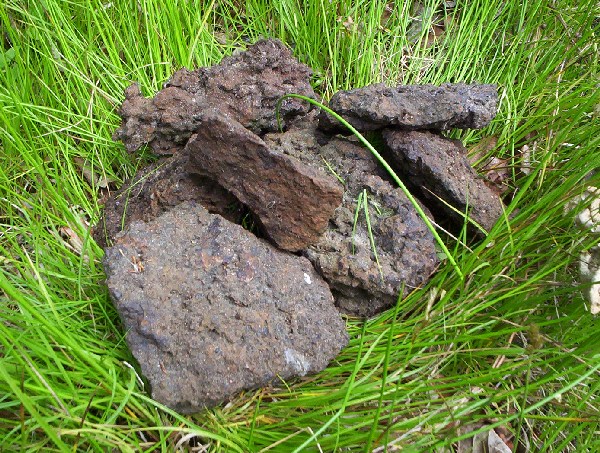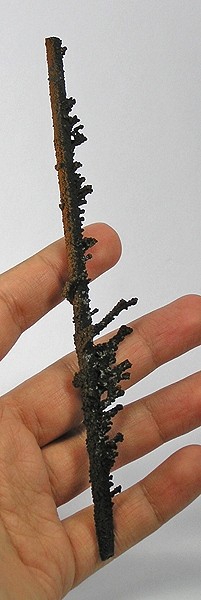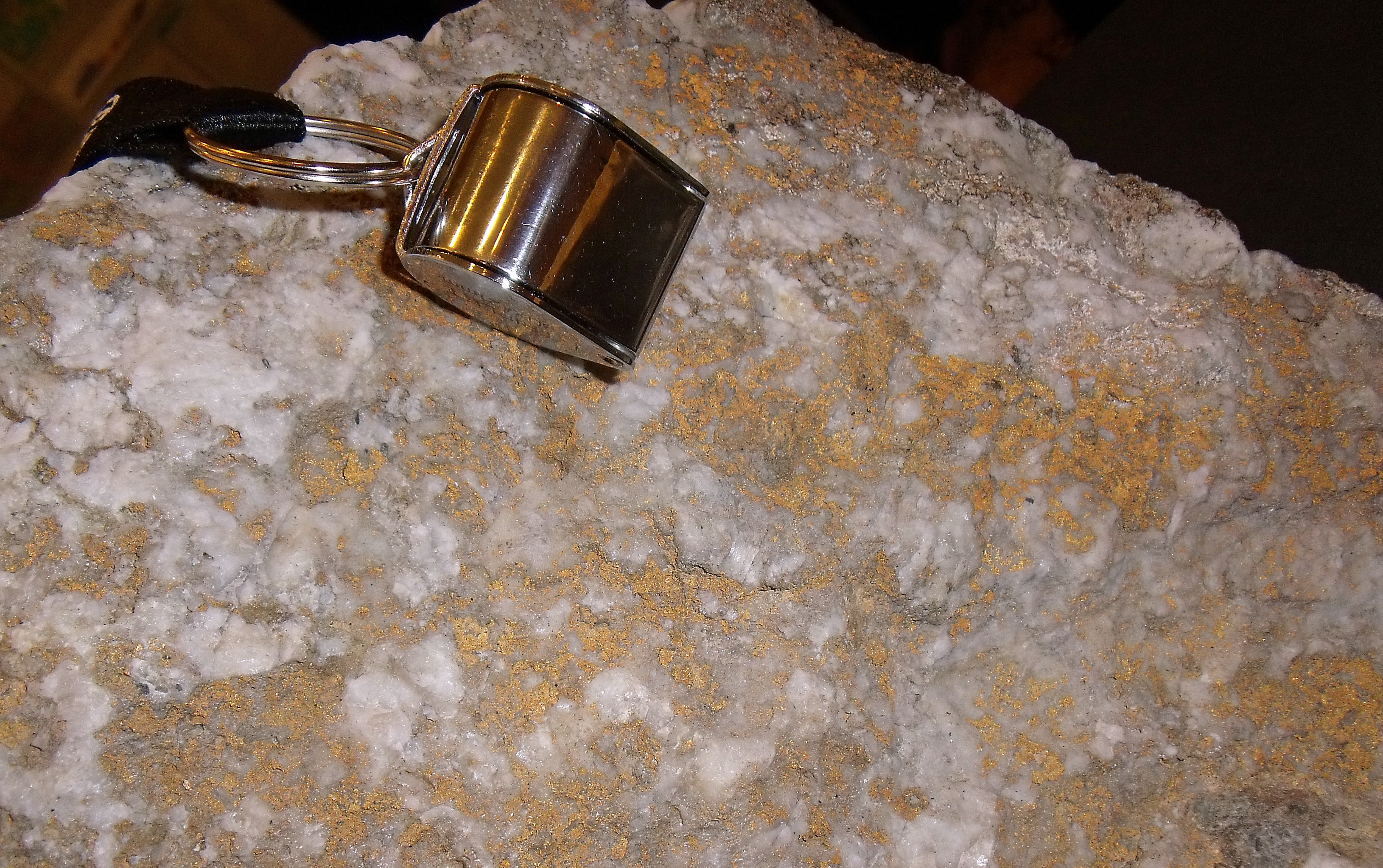|
Gossan
Gossan (eiserner hut or eisenhut) is intensely oxidized, weathered or decomposed rock, usually the upper and exposed part of an ore deposit or mineral vein. In the ''classic'' gossan or iron cap all that remains is iron oxides and quartz, often in the form of boxworks (which are quartz-lined cavities retaining the shape of the dissolved ore minerals). In other cases, quartz and iron oxides, limonite, goethite, and jarosite, exist as pseudomorphs, replacing the pyrite and primary ore minerals. Frequently, gossan appears as a red "stain" against the background rock and soil, due to the abundance of oxidized iron; the gossan may be a topographic positive area due to the abundance of erosion-resistant quartz and iron oxides. Although most gossans are red, orange, or yellow, black gossans from manganese oxides such as pyrolusite, manganite, and especially psilomelane Psilomelane is a group name for hard black manganese oxides including hollandite and romanechite. Psilomelane c ... [...More Info...] [...Related Items...] OR: [Wikipedia] [Google] [Baidu] |
Limonite
Limonite () is an iron ore consisting of a mixture of hydrated iron(III) oxide-hydroxides in varying composition. The generic formula is frequently written as , although this is not entirely accurate as the ratio of oxide to hydroxide can vary quite widely. Limonite is one of the three principal iron ores, the others being hematite and magnetite, and has been mining, mined for the production of iron since at least 400 BC. Names Limonite is named for the Ancient Greek word ( ), meaning "wet meadow", or ( ), meaning "marshy lake", as an allusion to its occurrence as in meadows and marshes. In its brown form, it is sometimes called brown hematite or brown iron ore. Characteristics Limonite is relatively density, dense with a specific gravity varying from 2.7 to 4.3.Northrop, Stuart A. (1959) "Limonite" ''Minerals of New Mexico'' (revised edition) University of New Mexico Press, Albuquerque, New Mexico, pp. 329–333, It is usually medium to dark yellowish brown in color. T ... [...More Info...] [...Related Items...] OR: [Wikipedia] [Google] [Baidu] |
Boxwork
In geology, boxwork is defined as a honeycomb-like structure that can form in some fractured or jointed sedimentary rocks. If the fractures in the host rock are mineralized, they can become more resistant to weathering than the surrounding rock, and subsequent erosion can produce boxwork structures. In mining geology, boxwork is a set of (typically) quartz-lined cavities, retaining the shape of the dissolved ore minerals, in gossans. In classical geology or mineralogy these mineral casts would not be called boxwork, but would instead be called pseudomorphs, or epimorphs. In cave geology, boxwork is an uncommon type of mineral structure, or speleogen (similar to a speleothem, but formed by erosion rather than accretion), occasionally found in caves and Erosion, erosive environments. Caves According to KellerLynn, "Boxwork is a speleogen, forming when bedrock between preexisting calcite veins were preferentially weathered away as the cave developed." Boxwork is commonly composed ... [...More Info...] [...Related Items...] OR: [Wikipedia] [Google] [Baidu] |
Goethite
Goethite (, ) is a mineral of the diaspore group, consisting of iron(III) oxide-hydroxide, specifically the α- polymorph. It is found in soil and other low-temperature environments such as sediment. Goethite has been well known since ancient times for its use as a pigment (brown ochre). Evidence has been found of its use in paint pigment samples taken from the caves of Lascaux in France. It was first described in 1806 based on samples found in the Hollertszug Mine in Herdorf, Germany. The mineral was named after the German polymath and poet Johann Wolfgang von Goethe (1749–1832). Composition Goethite is an iron oxyhydroxide containing ferric iron. It is the main component of rust and bog iron ore. Goethite's hardness ranges from 5.0 to 5.5 on the Mohs Scale, and its specific gravity varies from 3.3 to 4.3. The mineral forms prismatic needle-like crystals ("needle ironstone") but is more typically massive. Feroxyhyte and lepidocrocite are both polymorphs of ... [...More Info...] [...Related Items...] OR: [Wikipedia] [Google] [Baidu] |
Jarosite
Jarosite is a basic hydrous sulfate of potassium and ferric iron (Fe-III) with a chemical formula of KFe3(SO4)2(OH)6. This sulfate mineral is formed in ore deposits by the oxidation of iron sulfides. Jarosite is often produced as a byproduct during the purification and refining of zinc and is also commonly associated with acid mine drainage and acid sulfate soil environments. Physical properties Jarosite has a trigonal crystal structure and is brittle, with basal cleavage, a hardness of 2.5–3.5, and a specific gravity of 3.15–3.26. It is translucent to opaque with a vitreous to dull luster, and is colored dark yellow to yellowish-brown. It can sometimes be confused with limonite or goethite with which it commonly occurs in the gossan (oxidized cap over an ore body). Jarosite is an iron analogue of the potassium aluminium sulfate, alunite. Solid solution series The alunite supergroup includes the alunite, jarosite, beudantite, crandallite and florencite subgroups. Th ... [...More Info...] [...Related Items...] OR: [Wikipedia] [Google] [Baidu] |
Manganese
Manganese is a chemical element; it has Symbol (chemistry), symbol Mn and atomic number 25. It is a hard, brittle, silvery metal, often found in minerals in combination with iron. Manganese was first isolated in the 1770s. It is a transition metal with a multifaceted array of industrial alloy uses, particularly in stainless steels. It improves strength, workability, and resistance to wear. Manganese oxide is used as an oxidising agent, as a rubber additive, and in glass making, fertilisers, and ceramics. Manganese sulfate can be used as a fungicide. Manganese is also an essential human dietary element, important in macronutrient metabolism, bone formation, and free radical defense systems. It is a critical component in dozens of proteins and enzymes. It is found mostly in the bones, but also the liver, kidneys, and brain. In the human brain, the manganese is bound to manganese metalloproteins, most notably glutamine synthetase in astrocytes. Manganese is commonly found in labo ... [...More Info...] [...Related Items...] OR: [Wikipedia] [Google] [Baidu] |
Economic Geology
Economic geology is concerned with earth materials that can be used for economic and industrial purposes. These materials include precious and base metals, nonmetallic minerals and dimension stone, construction-grade stone. Economic geology is a subdiscipline of the geosciences; according to Lindgren (1933) it is “the application of geology”. It may be called the scientific study of the Earth's sources of mineral raw materials and the practical application of the acquired knowledge. The study is primarily focused on metallic mineral deposits and mineral resources. The techniques employed by other Earth science disciplines (such as geochemistry, mineralogy, geophysics, petrology, paleontology and structural geology) might all be used to understand, describe and exploit an ore deposit. Economic geology is studied and practiced by geologists. Economic geology may be of interest to other professions such as engineers, environmental scientists and conservationists because of the ... [...More Info...] [...Related Items...] OR: [Wikipedia] [Google] [Baidu] |
Century Dictionary And Cyclopedia
''The Century Dictionary and Cyclopedia'' is one of the largest encyclopedic dictionaries of the English language. It was compared favorably with the ''Oxford English Dictionary,'' and frequently consulted for more factual information than would normally be the case for a dictionary. History The ''Century Dictionary'' is based on '' The Imperial Dictionary of the English Language'', edited by Rev. John Ogilvie (1797–1867) and published by W. G. Blackie and Co. of Scotland, 1847–1850, which in turn is an expansion of the 1841 second edition of Noah Webster's ''American Dictionary''. In 1882 The Century Company of New York bought the American rights to ''The Imperial Dictionary'' from Blackie and Son. The first edition of the ''Century Dictionary'' was published from 1889 to 1891 by The Century Company, and was described as "six volumes in twenty four". The first edition runs to 7,046 pages and features some 10,000 wood-engraved illustrations. It was edited by Sanskrit s ... [...More Info...] [...Related Items...] OR: [Wikipedia] [Google] [Baidu] |
Prospectors
Prospecting is the first stage of the geological analysis (followed by exploration) of a territory. It is the search for minerals, fossils, precious metals, or mineral specimens. It is also known as fossicking. Traditionally prospecting relied on direct observation of mineralization in rock outcrops or in sediments. Modern prospecting also includes the use of geologic, geophysical, and geochemical tools to search for anomalies which can narrow the search area. Once an anomaly has been identified and interpreted to be a potential prospect direct observation can then be focused on this area. In some areas a prospector must also stake a claim, meaning they must erect posts with the appropriate placards on all four corners of a desired land they wish to prospect and register this claim before they may take samples. In other areas publicly held lands are open to prospecting without staking a mining claim. Historical methods The traditional methods of prospecting involved co ... [...More Info...] [...Related Items...] OR: [Wikipedia] [Google] [Baidu] |
Psilomelane
Psilomelane is a group name for hard black manganese oxides including hollandite and romanechite. Psilomelane consists of hydrous manganese oxide with variable amounts of barium and potassium. Psilomelane is erroneously, and uncommonly, known as black hematite, despite not being related to true hematite, which is an iron oxide. Formula Generalized formula may be represented as or as . It is sometimes considered to be a hydrous manganese manganate, but of doubtful composition. The amount of manganese present corresponds to 70-80% of Manganese(II) oxide, manganous oxide with 10-15% of available oxygen. Characteristics Psilomelane has no definite chemical composition and occurs as botryoidal and Speleothem, stalactitic masses with a smooth shining surface and submetallic lustre. The mineral is readily distinguished from other hydrous manganese oxides (manganite and Wad (mineral), wad) by its greater Mohs scale of mineral hardness, hardness 5 to 6; the specific gravity varies fro ... [...More Info...] [...Related Items...] OR: [Wikipedia] [Google] [Baidu] |
Manganite
Manganite is a mineral composed of manganese oxide-hydroxide, MnO(OH), crystallizing in the monoclinic system (pseudo-orthorhombic). Crystals of manganite are prismatic and deeply striated parallel to their length; they are often grouped together in bundles. The color is dark steel-grey to iron-black, and the Lustre (mineralogy), luster brilliant and submetallic. The streak is dark reddish brown. The Mohs hardness, hardness is 4, and the specific gravity is 4.3. There is a perfect cleavage parallel to the brachypinacoid, and less-perfect cleavage parallel to the prism faces. Crystal twinning, Twinned crystals are not infrequent. The mineral contains 89.7% manganese sesquioxide; it dissolves in hydrochloric acid with evolution of chlorine. Occurrence Manganite occurs with other manganese oxides in deposits formed by circulating meteoric water in the weathering environment in Clay mineral, clay deposits and laterites. It forms by low temperature hydrothermal action in Vein (geolo ... [...More Info...] [...Related Items...] OR: [Wikipedia] [Google] [Baidu] |
Pyrolusite
Pyrolusite is a mineral consisting essentially of manganese dioxide ( Mn O2) and is important as an ore of manganese.. It is a black, amorphous appearing mineral, often with a granular, fibrous, or columnar structure, sometimes forming reniform crusts. It has a metallic luster, a black or bluish-black streak, and readily soils the fingers. The specific gravity is about 4.8. Its name is from the Greek for ''fire'' and to ''wash'', in reference to its use as a way to remove tints from glass. Occurrence Pyrolusite and romanechite are among the most common manganese minerals. Pyrolusite occurs associated with manganite, hollandite, hausmannite, braunite, cryptomelane, chalcophanite, goethite, and hematite under oxidizing conditions in hydrothermal deposits. It also occurs in bogs and often results from alteration of manganite. Use The metal is obtained by reduction of the oxide with sodium, magnesium, aluminium, or by electrolysis. Pyrolusite is extensively used for the ... [...More Info...] [...Related Items...] OR: [Wikipedia] [Google] [Baidu] |







